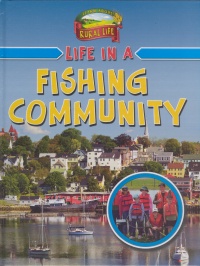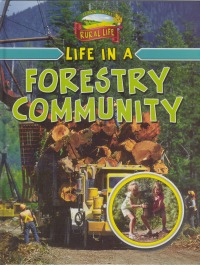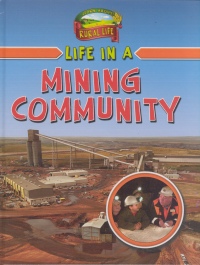| ________________
CM . . . . Volume XVI Number 25. . . .March 5, 2010.
excerpt:
Many small communities have developed around natural resources. The �Learn About Rural Life� series, comprised of four titles, examines various resources and everyday life in a few of the North American towns that sprang up around them. Each of the books begins in a similar fashion, explaining the difference between an urban area and a rural area, followed by information about the featured resource and how it is used. It then focuses on a specific rural community, discussing the impact that the natural resource has had on the community�s inhabitants. Other information includes the town�s history, natural surroundings, native animals, and the daily life of its people with respect to housing, schools, jobs, and recreational activities. (It is interesting to note that, as many of the resources are decreased or depleted, the towns have resorted to tourism for their economy.) There is also a chapter devoted to similar communities in other parts of the world. The last of the 14 chapters provides three interesting facts about the topic as well as a map of North America indicating the major areas of the featured resource. A table of contents, a glossary, an index and a list of books and web sites for further study are included. The text is written in fairly short sentences and is easy to comprehend. Illustrations consist mainly of colour photographs, the majority of which depict places in Canada and the United States. There are some aerial views as well as black and white archival photographs. All of the illustrations are labeled, providing additional information. Life in a Farming Community looks at livestock and crop farming, the work involved in running a farm, the technological changes in farm machinery over time, and the many products which originate on farms, such as fruits and vegetables, meats, wool, cotton, linen (flax), dairy products and plant fuels. The Wisconsin town of Monticello (pop. 1200), known for its cheese, is featured. Readers will learn about the operations of a dairy farm and some food-processing plants. There are several types of fishing- angling, scooping with metal rakes, trapping, and fishing with gill and trawler nets. In Life in a Fishing Community, the spotlight is on Lunenburg, NS, where commercial fishermen bring in their daily catches of lobsters and huge trawlers with 25 people on board spend several days at sea, preparing and freezing fish right on the boat. With fishing as the town�s major resource, there are a number of other fishing-related jobs: harbor masters, dockers, coastguards and crane and fork-lift operators as well as workers at the fish-processing factory. Visitors to Lunenburg might enjoy a tour of the Fisheries Museum of the Atlantic or The Waterfront and Seafood Festival, held every September. Nearly 30 per cent of the Earth�s surface is covered by forests. Life in a Forestry Community highlights the process involved in converting the raw material, a tree, to lumber, the many uses of lumber, including framing for buildings, veneers for plywood and furniture, and fibers for paper and cardboard, and the development of new types of trees that are more disease and pest-resistant. Life in the British Columbia town of Mackenzie is featured. Though Mackenzie�s inhabitants, many of whom work at lumber mills, rely heavily on forestry, decreased sales of wood products in North America have resulted in the town�s looking for other ways to stimulate the economy. Tourism and mining are attracting more job-seekers. Life in a Mining Community examines Wright, WY, a relatively young coal-mining town established in 1976. From its beginnings as a community of mobile homes, an elementary school and a few stores, Wright has grown into a town with permanent homes, a high school, library, post office, recreation centre, golf course, parks and walking trails. This book explains the steps involved in taking the coal from the surface mine to the power plant as well as what happens when the mine is depleted of minerals. As well as the obvious common factor, that of being centred around a natural resource, all of the featured towns share a strong sense of community and a willingness to adapt in case of the depletion of natural resources. Many of them have turned to tourism in order to survive and seem to be quite successful. Astute readers will understand that life in a rural community is not so different from life in a large urban area. City kids go to school, play sports, and enjoy many of the same activities as do their rural counterparts. These titles would be useful in a primary social studies curriculum. Recommended. Gail Hamilton is a former teacher-librarian in Winnipeg, MB.
To comment on this title or this Review by Gail Hamilton., send mail to cm@umanitoba.ca. Copyright © the Manitoba Library Association. Reproduction for personal use is permitted only if this copyright notice is maintained. Any other reproduction is prohibited without permission.
NEXT REVIEW | TABLE OF CONTENTS FOR THIS ISSUE- March 5, 2010. Heather C. Hudak, editor.S | TITLES | MEDIA Review by Gail Hamilton.S | PROFILES | BACK ISSUES | SEARCH | CMARCHIVE | HOME |



